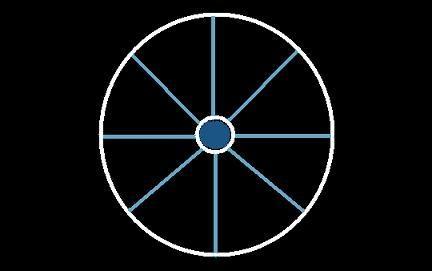

The previous section Part XVI dealt with a group of partial border 7×7 squares with non magic internal 3×3 squares. Attempts were made to use the same algorithms as used in Part XVI to construct 9th order squares but were unsuccessful. Construction of the 9th order, however, was possible using several octogonal algorithms to generate the partial border squares. It was found that one type of square (Non Border A5) constructed via parity Part III could be converted into the simpler looking Non Border 9a(4,8,12) below which could then be transformed into a partial border square where its complementary table had a more complex structure.
It was found that he number of algorithms required to fill in the non spoke sections for the square derived from A5 was found to be between 4 and 5 and probably will grow in numbers as the order of the square increases. So it was decided to focus on only one 9th order square which, however, will be depicted without the algorithms. Instead I will depict the squares and how the connections between the non spoke numbers in the complementary table differ from each other. The first square 9a and its accompanying complementary table was constructed from A5 by moving the lower numbers from the inner portion of the square to the periphery of the square and vice versa:

|
⇒ |
|
We can convert 9a to a different square 9b by exchanging the numbers 15 and 19 in the first column with 16 and 20 in the last column. In addition, shifting the numbers 22, 23, 21, and 24 to different positions on the perimeter of the square requires that the internal numbers be modified so as to maintain a Sum of 369 for each row and column. The partial complementary table of 9b shows that the connections between numbers is now more complex as depicted below and again with four different kinds of octogonal algorithms:

| 77 | 13 | 17 | 23 | 1 | 61 | 64 | 68 | 45 |
| 67 | 76 | 29 | 25 | 2 | 55 | 56 | 44 | 15 |
| 63 | 47 | 75 | 33 | 3 | 51 | 43 | 35 | 19 |
| 58 | 54 | 49 | 74 | 4 | 42 | 36 | 28 | 24 |
| 9 | 10 | 11 | 12 | 41 | 70 | 71 | 72 | 73 |
| 22 | 30 | 31 | 40 | 78 | 8 | 48 | 52 | 60 |
| 20 | 32 | 39 | 46 | 79 | 34 | 7 | 50 | 62 |
| 16 | 38 | 53 | 57 | 80 | 27 | 26 | 6 | 66 |
| 37 | 69 | 65 | 59 | 81 | 21 | 18 | 14 | 5 |
We can convert 9b to 9c six units to the right by shifting all the non spoke numbers and moving the terminal structure starting at 31 to position 13. The internal numbers 31-36 now take on the values 13-18 with all the other non spoke numbers changing as well. This shift of 6 units to the right changes the complementary table to:

producing square 9c while using the same Octagonal algorithms as 9b:
| 77 | 19 | 23 | 29 | 1 | 55 | 58 | 62 | 45 |
| 61 | 76 | 35 | 31 | 2 | 49 | 50 | 44 | 21 |
| 57 | 65 | 75 | 15 | 3 | 69 | 43 | 17 | 25 |
| 52 | 48 | 67 | 74 | 4 | 42 | 18 | 34 | 30 |
| 9 | 10 | 11 | 12 | 41 | 70 | 71 | 72 | 73 |
| 28 | 36 | 13 | 40 | 78 | 8 | 66 | 46 | 54 |
| 26 | 14 | 39 | 64 | 79 | 16 | 7 | 68 | 56 |
| 22 | 38 | 47 | 51 | 80 | 33 | 32 | 6 | 60 |
| 37 | 63 | 59 | 53 | 81 | 27 | 24 | 20 | 5 |
On the other hand, it is possible to produce higher order squares using parity (knowing which odd and even complementary sums are required to fill in a row or column). Once the square is constructed one can determine which algorithms to use to fill in the non spoke numbers as well as the connectivity between numbers in the complementary table. It's a much easier task than trying to build the square from scratch without the requisite algorithms.
This completes Part XVII. Go back to Part XVI. Go back to homepage.
Copyright © 2022 by Eddie N Gutierrez. E-Mail: enaguti1949@gmail.com